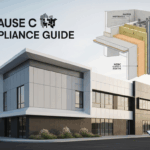What is a Fire Resistance Rating (FRR)?
Complete Guide to Fire Resistance Rating 60/60/60 NZ – A Fire Resistance Rating (FRR) is a grading period, expressed in minutes, that defines the fire resistance of a passive fire protection system or building element. It is not simply a measure of how long something takes to burn, but rather a precise assessment of its performance against three specific criteria during a standardised fire test.
These ratings are a cornerstone of the New Zealand Building Code, particularly under Clause C ‘Protection from Fire’. The code’s objective is to ensure that people have sufficient time to escape a building during a fire and that the fire’s spread is sufficiently contained to allow for firefighting operations and to protect neighbouring properties. An FRR provides a predictable, tested benchmark for walls, floors, ceilings, doors, and structural elements to meet these safety objectives.

Decoding the Fire Resistance Rating 60/60/60 NZ
The three numbers in an FRR each represent a distinct performance measure, always in the same order. For a fire resistance rating 60/60/60 NZ, each number signifies that the building element must maintain its specific function for a minimum of 60 minutes when exposed to a standard fire. Let’s break down what each ’60’ stands for.
The First ’60’: Structural Adequacy
Structural Adequacy is the ability of a load-bearing element to maintain its load-bearing capacity and function without collapse during a fire. This criterion applies to elements that are part of the building’s structural frame, such as beams, columns, load-bearing walls, and floor systems.
For a system rated with 60 minutes of structural adequacy, it must support its designated design load for at least that duration while being subjected to the intense heat of a standard fire test. This is crucial for preventing the catastrophic collapse of a building, which would not only trap occupants but also pose an extreme danger to firefighters. It ensures the building’s skeleton remains stable long enough for evacuation and emergency response.
The Second ’60’: Integrity
Integrity refers to the ability of a building element to prevent the passage of flames and hot gases from one side to the other. This measure is about containment. It applies to non-load-bearing and load-bearing elements that act as barriers, such as walls, floors, and fire doors.
A rating of 60 minutes for integrity means that for that period, the element must not develop any cracks, fissures, or openings through which fire or hot gases could pass and ignite materials on the non-fire side. Maintaining integrity is vital for compartmentalising a fire, limiting its spread to other parts of the building, and protecting escape routes like corridors and stairwells from becoming filled with smoke and flame.
The Third ’60’: Insulation
Insulation is the element’s ability to limit the temperature rise on the non-exposed side (the “cold face”). While an element might successfully stop flames (Integrity), the intense heat can still conduct through it, potentially igniting combustible materials or making an escape route untenable for people.
A 60-minute insulation rating ensures that the temperature on the non-fire side of the barrier does not exceed a specified limit (typically an average of 140°C above ambient) for at least 60 minutes. This prevents the fire from spreading by radiation and convection, protecting valuable assets, sensitive equipment, and, most importantly, people seeking refuge or evacuating on the other side of the barrier.
The NZ Building Code and the 60/60/60 Mandate
The requirement for a specific fire resistance rating 60/60/60 NZ is not arbitrary; it is mandated by the New Zealand Building Code through its Acceptable Solutions documents. These documents provide a pre-approved pathway to demonstrate compliance with the code’s performance requirements.
Key Clauses in the NZ Building Code
The primary reference for fire safety is Clause C of the New Zealand Building Code, which covers Protection from Fire. Compliance is typically demonstrated using the Acceptable Solutions C/AS1 through C/AS7, which apply to different building types and risk levels.
These documents outline specific FRR requirements for various building elements based on factors such as:
- Building Use and Occupancy: A hospital or a large apartment building will have stricter requirements than a small, standalone retail shop.
- Building Height and Size: Taller and larger buildings present greater risks and require more robust fire separation.
- Proximity to Boundaries: The distance to a property line or another building influences the required FRR for external walls to prevent fire spread between properties.
- Occupant Load: The number of people the building is designed for affects the requirements for safe egress paths.
Where is a Fire Resistance Rating of 60/60/60 NZ Typically Required?
A 60/60/60 FRR is a common requirement in many construction scenarios across New Zealand. Its balanced performance makes it suitable for providing a solid hour of protection, which is considered sufficient for many medium-risk situations.
Inter-tenancy Walls and Floors
One of the most frequent applications for a fire resistance rating 60/60/60 NZ is in the construction of inter-tenancy walls and floors. These elements separate different tenancies or household units within the same building.
- Apartment Buildings: Walls and floors separating individual apartments must have a 60/60/60 FRR to ensure a fire in one unit is contained and does not spread to adjacent units, giving other residents ample time to evacuate.
- Terraced Houses: The party walls between attached townhouses or terraced homes require this rating.
- Commercial Buildings: In a multi-tenant office building or a shopping mall, the walls separating one shop or office from another need to meet this standard.
Boundary Walls and External Walls
When a building is constructed close to a property boundary, its external walls may need a specific FRR to protect the neighbouring property from fire and vice-versa. The exact requirement depends on the distance to the ‘notional boundary’. Walls that are relatively close (often within a few metres) will typically require a 60/60/60 FRR. This prevents a fire from easily jumping from one building to the next.
Fire-Rated Corridors and Egress Paths
Protecting escape routes is a primary goal of passive fire protection. Corridors, lobbies, and stairwells that are designated as safe paths for evacuation often require their enclosing walls and floors/ceilings to have a specific FRR. A 60/60/60 rating ensures that these paths remain free of smoke, flame, and excessive heat for at least an hour, allowing occupants to exit the building safely.
Separating Different Building Uses
When a single building contains different use cases (e.g., a retail space on the ground floor with apartments above), the floor/ceiling assembly separating these two areas often requires a 60/60/60 FRR. This separation accounts for the different fire risks associated with commercial versus residential activities.
How to Achieve a 60/60/60 Fire Resistance Rating
Achieving a compliant fire resistance rating 60/60/60 NZ is not about using a single “fireproof” material. Instead, it is about constructing a complete, tested system. The performance of the system depends on all its components and, crucially, on the quality of its installation.
Common Materials and Systems
Several well-established construction systems can be used to meet the 60/60/60 standard. The choice often depends on factors like cost, acoustics, structural requirements, and ease of construction.
- Fire-Rated Plasterboard Systems: This is one of the most common methods. A typical system for a wall might involve a timber or steel stud frame lined on both sides with two layers of 13mm or a single layer of 16mm fire-rated plasterboard (e.g., GIB Fyreline®). The specific type of plasterboard, screw spacing, jointing compound, and insulation within the cavity are all critical parts of the tested system.
- Concrete and Masonry: Solid concrete panels or concrete masonry block walls, when constructed to a certain thickness (e.g., 90mm or more), can inherently achieve a 60/60/60 FRR or higher. Their mass and non-combustible nature provide excellent structural adequacy, integrity, and insulation.
- Proprietary Fire-Rated Panels: Various manufacturers offer specialised panel systems designed for fire resistance. These can include composite panels or specialised calcium silicate boards that offer high performance in a relatively thin profile.
The Critical Role of Penetrations
A fire-rated wall or floor is only as good as its weakest point. Any opening or penetration made for services like pipes, cables, or ducts must be protected to the same FRR as the element it passes through. If this is not done correctly, the penetration becomes a direct pathway for fire and smoke, completely negating the barrier’s rating.
Achieving this requires the use of tested fire stopping products:
- Fire Collars: These are fitted around plastic pipes. In a fire, the intumescent material inside the collar expands rapidly to crush the melting pipe and seal the opening.
- Fire-Rated Sealants and Mastics: Used to seal gaps around cables, metal pipes, and joints. They expand when heated to form a robust insulating char.
- Fire Dampers: Installed in ventilation ducts, these are designed to close automatically in the event of a fire, preventing it from spreading through the HVAC system.
The Importance of Correct Installation and Certification
A fire resistance rating 60/60/60 NZ is only valid if the system is installed exactly as it was tested and specified by the manufacturer. Deviating from the specifications—using the wrong type of screws, incorrect stud spacing, or substituting a non-tested product—will void the rating.
For this reason, it is essential to:
- Follow Manufacturer’s Specifications: Always adhere strictly to the technical literature provided for the specific fire-rated system.
- Use Certified Installers: Employing tradespeople with proven experience and certification in passive fire protection provides greater assurance of a compliant installation.
- Obtain Documentation: During construction, it is vital to document all passive fire protection systems and their installation, a process often managed through Producer Statements (PS3 for construction) which are required for obtaining a Code Compliance Certificate (CCC).

Testing and Compliance Verification
A system’s FRR is not just an estimate; it is determined through rigorous physical testing in an accredited laboratory according to standards like AS 1530.4 – “Methods for fire tests on building materials, components and structures – Part 4: Fire-resistance test of elements of construction.”
During this test, a full-scale prototype of the wall or floor system is built into a furnace. It is then subjected to a controlled blaze that follows a standard time-temperature curve, while being monitored for structural adequacy, integrity, and insulation. The system earns its rating based on how many minutes it successfully meets all three criteria. This empirical evidence is what provides confidence that the system will perform as expected in a real fire.
Conclusion
The fire resistance rating 60/60/60 NZ is far more than a technical specification; it is a critical life-safety standard embedded in New Zealand’s construction landscape. It represents a 60-minute commitment to Structural Adequacy, ensuring a building won’t collapse prematurely; Integrity, ensuring flames and hot gases are contained; and Insulation, ensuring heat won’t spread to ignite adjacent areas. This three-pronged approach is fundamental to creating buildings that provide occupants with precious time to escape and give firefighters a safer environment to operate in.
Achieving a compliant 60/60/60 rating requires a holistic understanding of tested systems, meticulous attention to installation detail, and proper protection of all service penetrations. For anyone involved in designing, building, or managing property in New Zealand, a thorough grasp of this standard is not just best practice—it is an essential responsibility in building a safer future. Always consult with qualified professionals like fire engineers and architects to ensure your project meets all requirements of the New Zealand Building Code.






